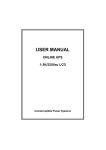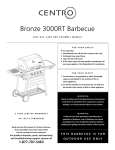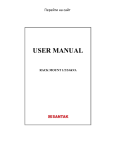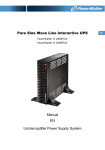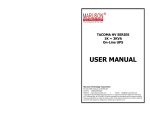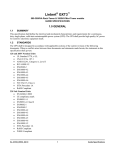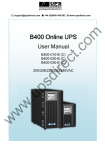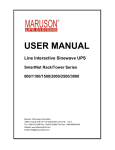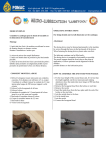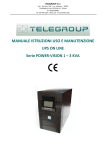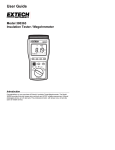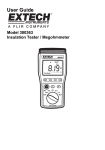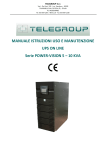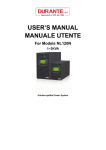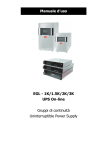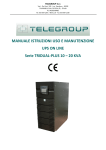Download SERVICE MANUAL - MARUSON Technology
Transcript
ARMADA RACK/TOWER SERIES 1K ~ 3KVA On-Line UPS SERVICE MANUAL Maruson Technology Corporation P.O. Box 1986, Walnut, CA 91788 USA Toll Free: 1-888-MARUSON Website: www.MarusonUSA.com | E-Mail: [email protected] *Copyright © 2012 All Rights Reserved. Maruson® is a registered trademark of Maruson Technology (U.S. Trademark Reg. No. 3,150,957). All other trademarks are the property of their respective owners. Product specifications are subject to change without notice. Battery backup time is based on half load and varies with equipment, configuration, battery age, temperature, etc. Content 1.Product Introduction........................................................................... 2 1.1 System Production......................................................................... 2 1.2 Display Panel ................................................................................. 2 1.3 Product Specification ..................................................................... 6 1.4 Communication Port ...................................................................... 8 2.Installation ........................................................................................... 9 2.1 Installation Safety Instructions ....................................................... 9 2.2 Unpack and Inspection ................................................................ 10 2.3 Installation steps ...........................................................................11 3.Operation ........................................................................................... 13 3.1 Operation Safety Instructions ...................................................... 13 3.2 Battery Charge............................................................................. 14 3.3 Setting by LCD module................................................................ 14 3.4 Turn On the UPS ......................................................................... 17 3.5 Connect the loads to the UPS ..................................................... 18 3.6 Turn Off the UPS ......................................................................... 18 3.7 Test Function................................................................................ 18 3.8 Mute the buzzer ........................................................................... 18 4. Operating mode ................................................................................ 19 4.1 Line mode .................................................................................... 19 4.2 Battery mode ............................................................................... 20 4.3 Bypass mode ............................................................................... 21 4.4 No output mode ........................................................................... 22 4.5 Abnormal mode............................................................................ 22 5. Maintenance...................................................................................... 23 5.1 Maintenance Safety Instructions ................................................. 23 5.2 Trouble shooting .......................................................................... 24 6. Software ............................................................................................ 26 Appendix: Rear Panel .......................................................................... 27 -1- 1.Product Introduction 1.1 System Production This On-Line-Series is an uninterruptible power supply incorporating double-converter technology. It provides perfect protection specifically for Novell, Windows NT and UNIX servers. The double-converter principle eliminates all mains power disturbances. A rectifier converts the alternating current from the socket outlet to direct current. This direct current charges the batteries and powers the inverter. On the basis of this DC voltage, the inverter generates a sinusoidal AC voltage, which permanently supplies the loads. Computers and periphery are thus powered entirely by the mains voltage. In the event of power failure, the maintenance-free batteries power the inverter. 1.2 Display Panel The Display Panel -2- Switch ON-Button OFF-Button Select-Button Enter-Button Function Turn on UPS system: By pressing the ON-Button “I” the UPS system is turned on. Deactivate acoustic alarm: By pressing this Button an acoustic alarm can be deactivated. When mains power is normal, the UPS system switches to No output or Bypass mode by pressing OFF-Button “ “, and the inverter is off. At this moment, if Bypass is enabled, then the output sockets are supplied with voltage via the bypass if the mains power is available. If the UPS system is No output or Bypass mode, the output voltage and frequency and Bypass disable/enable could be selected by pressing Select-Button, and confirmed by pressing Enter-Button. If the UPS system is No output or Bypass mode, the output voltage and frequency and Bypass disable/enable could be selected by pressing Select-Button, and confirmed by pressing Enter-Button. The LCD Display Display Function Input Information Indicates the input Line voltage value, which could be displayed from 0 to 999Vac Indicates the frequency value of input Line voltage, which could be displayed from 0 to 99Hz Indicates the input Line voltage is higher than the SPEC range, and the UPS would be working in Battery mode -3- Indicates the input Line voltage is lower than the SPEC range, and the UPS would be working in Battery mode Indicates the input power state, it would always be displayed Indicates the input power is off only if it is displayed Output Information Indicates the UPS output voltage value, which could be displayed from 0 to 999Vac Indicates the frequency value of the UPS output voltage, which could be displayed from 0 to 99Hz Indicates the UPS output state, it would always be displayed Indicates the UPS output is shut off only if it is displayed Load Information Indicates the load percent in Watt or VA, only the maximum value of them could be displayed from 0 to 199% Indicates the load or the UPS output is short and the UPS would shut down Indicates the load is over the SPEC range Indicates the load percent, and every grid represent 25% load. Indicates the load is over the SPEC range Battery Information Indicates the battery voltage value, which could be displayed from 0 to 999Vdc Indicates the battery capacitance percent, and every grid represent 25% capacitance. -4- Indicates the UPS is working in the battery mode, and the battery is discharged for supplying the load Indicates the battery is over charged, and the UPS would be switched to Battery mode Indicates the battery is weak, and the UPS would shut down soon Mode/Fault/Warning UPS Operating Information Indicates the operating mode of the UPS, Mode code or Fault code or Warning code could be displayed, and the codes are illuminated in detail in the following chapter Indicates the UPS is working in bypass mode, the load is directly supplied by the input power through bypass Indicates the UPS is working in no output mode Indicates the UPS is working in line mode Indicates the UPS is working in battery mode Indicates the UPS is working in fault mode Indicates some warnings occur which need be attention Indicates the UPS is abnormal in which some faults or warnings occur Output voltage and frequency and Bypass disable/enable selection Information The four value of the output voltage could be selected when the UPS is in No output or Bypass mode, and only one of them could be active in the same time. Derating 10% when the output voltage is adjusted to 208VAC -5- The two frequency value of the output voltage could be selected when the UPS is in No output or Bypass mode, and only one of them could be active in the same time Bypass disable or enable could be selected when the UPS is in No output or Bypass mode, and only one of them could be active in the same time 1.3 Product Specification 1.3.1Electrical specifications Model ARM-1000RT(L) ARM-1500RT(L) ARM-3000RT(L) INPUT Voltage 110/115/120VAC Frequency 46Hz ~ 54Hz / 55Hz ~ 65Hz Amperage(maximum) 10A 15A 30 A 1.5kVA 1.05kW 3kVA 2.1kW OUTPUT 1kVA 0.7k W Power rating Voltage 110/115/120VAC Frequency (50Hz/60Hz)±0.2Hz (Battery Mode) Wave form Sinusoidal BATTERIES (STANDARD) Number and type 3x12V7.2Ah 4x12V7.2Ah 8x12V7.2Ah 1.3.2Typical stored energy time (Battery mode) Typical values at 25°C in minutes: Model 100 % Load 50 % Load 1K 5 14 1.5K 5 14 3K 5 17.5 1.3.3 MECHANICAL data Model Net Weight (kg) -6- Dimention (mm) 1KL 9.3 Battery Pack 36V 22.7 1.5K 21.2 1.5KL 11.7 Battery Pack 96V 28.0 3K 11.4 3KL 12.5 Battery Pack 96V 27.8 44.5 16.5 88.0(2U) 1K 465.0 482.6 Depth: 470 1.3.4 Operating environment Ambient temperature 0℃ to 40℃ Operating humidity <95% Altitude <1000m Storage temperature 0℃~40℃ 1.3.5 Standards * Safety IEC/EN 62040-1-1 * EMI Conducted Emission.........................:IEC/EN 62040-2 Category C1 Radiated Emission............................:IEC/EN 62040-2 Category C1 Harmonic Current..............................:IEC/EN 61000-3-2 (Input Current≤16A) Voltage Fluctuation and Flicker..........:IEC/EN 61000-3-3 (Input Current≤16A) * EMS ESD...................................................:IEC/EN 61000-4-2 Level 4 RS......................................................:IEC/EN 61000-4-3 Level 3 EFT....................................................:IEC/EN 61000-4-4 Level 4 -7- SURGE..............................................:IEC/EN 61000-4-5 Level 4 CS......................................................:IEC/EN 61000-4-6 Level 3 Power-frequency Magnetic field.........:IEC/EN 61000-4-8 Level 3 Low Frequency Signals......................:IEC/EN 61000-2-2 1.4 Communication Port The communication port is for the monitoring software. The RS232 is provided by the UPS to communicate with a host computer. It can transmits both utility power and UPS status to the host computer, providing the host computer with proprietary command sequence to monitor the utility power and UPS status and to control the UPS output through the port. 1.4.1 RS232 Interface The following is the pin assignment and description of DB-9 connector. Pin # Description I/O 2 TXD Output 3 RXD Input 5 GND Input 1.4.2 AS400 Interface (Option) This series UPS also has AS400 card (an optional accessory) for AS400 communication protocol. Please contact your local distributor for details. The following is the pin assignment and description of DB-9connector in AS400 card. Pin # Description I/O Pin # Description I/O 1 UPS Fail Output 6 Bypass Output 2 Summary Alarm Output 7 Battery Low Output 3 GND Input 8 UPS ON Output -8- 4 Remote Shutdown Input 5 Common Input 9 Line Loss Output DB-9 Interface of AS400 communication protocol 2.Installation You must read the following safety instructions before installation! 2.1 Installation Safety Instructions ● The system must be installed and wired only by qualified electricians in accordance with applicable safety regulations! ● Do not install and operate the -9- UPS when water condensation happen which may occur if the UPS is moved directly from a cold to a warm environment. The UPS must be absolutely dry before being installed and operated. Please allow an acclimatization time of at least 2 hours. Otherwise there is hazard of electric shock! ● Do not install the UPS in the environment where it is damp or would be exposed to direct sunlight or near heat. Ensure the UPS is far away from water, inflammable gas and corrosive agents. ● Do not block air vents in the housing of UPS. The UPS must be installed in a location with good ventilation. Ensure enough space on each side for ventilation. ● Installation and Wiring must be performed in accordance with the local electrical laws and regulations. ● The UPS must be securely grounded. If there are external UPS battery cabinets, please make sure the battery cabinets have the equipotential earth bonding to the UPS main cabinet. ● An appropriate switch device as backup protection for over-current or short-circuit should be provided in the input utility. ● Strictly follow the principle of “same voltage, same type” when paralleling multi battery packs. ● DC breaker or fuse must be used as a protection device between the external battery pack and the UPS. The spec of protection must be matched to the UPS specification. 2.2 Unpack and Inspection 2.2.1 Unpack the package and check the contents. The shipped package contains: ● 1 UPS ● 1 user manual 2.2.2 Inspect the appearance of the UPS to see if there is any damage during transportation. Do not turn on the unit and notify the dealer immediately if there is any damage or lack of some parts. Note: Please ensure that the incoming feeder is isolated and secured to prevent it from being -10-switched back on again. 2.3 Installation steps 2.3.1Before connection 1) Make sure the wire / circuit breaker / socket are enough for the current rating of UPS to avoid the hazards of electric shock and fire. Pay attention to the capacity of the socket: 2) Make sure the mains switch in the building is cut off. 3) Make sure the UPS is not be turned on before wiring operation. 4) Turn off all load switches first before connecting the load to the UPS. 5) Make sure the protective earth ground is correct. 2.3.2UPS Input Connection The input of 1K(L) and 1.5K(L) are socket-types only. Simply plug the load power cord to the output sockets to complete connection. Besides output sockets, 3K/3KL has the terminal block available for output as well. The following is the wiring configuration of the terminal a) Remove the small cover of the terminal block b) Use AWG14 or 2.1mm2 wires for wiring configuration c) Upon completion of the wiring configuration, please check whether the wires are securely affixed. d) Put the small cover back to the rear panel. Connection diagram 2.3.3 External battery connection (for long backup time model --“L” model) 1) Use the battery pack with-11-voltage: 36VDC for 1KL/ (6pcs of 12V batteries parallel as two groups), 48VDC for 1.5KL (8pcs of batteries parallel as two groups), 96VDC for 3KL (8 pcs of 12V batteries). Connection of batteries more than or less than required will cause abnormality. 2) One end of the external battery cord is a plug for connecting the UPS and the other end has a plug for connecting the user battery cabinet. 3) Do not connect the UPS to any load yet. Then, connect the power cord of the UPS to supply utility power to the UPS to make the UPS operate in utility power mode. 4) Connect the plug of the external battery cord to the external battery socket on the rear panel of the UPS to complete the connection procedure and the UPS will start to charge the battery pack. 5) The "+" terminal of the battery. The black wire is connected to the "-" terminal of the battery. (Note: the green/yellow wire is grounded for protection purpose.) 2.3.4 UPS Output Connection Connect the loads to the UPS through the output sockets or the terminal of the rear panel to complete the installation. Caution! The output sockets of the UPS system may still be electrically live even if the power supply system has been disconnected or the Bypass switch is on “OFF” position. 2.3.5 Computer Connection: Connect your computer to the output sockets of the UPS system following the above diagram. Caution! Do not connect equipment which would overload the UPS system (e.g. laser printers) -12- 3.Operation You must read the following safety instructions before operation! 3.1 Operation Safety Instructions ● Laymen can operate this product. ● Do not disconnect the earth conducting wire on the UPS or the building wiring terminals in any time since this would cancel the protective earth of the UPS system and all connected loads. ● Do not try to disassemble the original part of the UPS before turn off and disconnect it from the mains power & external battery. ● The UPS output socket may be electrically lived even if the UPS system is not connected to the mains power source. ● Do not make any liquid and foreign objects enter the UPS. ● Turn off the mains input switch and external battery switch -13- immediately at any accident of electric shock and fire related to the UPS. 3.2 Battery Charge If the wiring is correct, turn on the mains breaker in your building. The power supply inside the UPS will be started automatically, the fans will run, and the panel will display with bypass mode. Note: In bypass mode the load is not protected. The power is supplied directly from the mains .You should go on to the next step to turn on the UPS for protecting your load. It is recommend you to fully charge the batteries of the UPS system by leaving the UPS system connected to the mains for 1-2 hours. You may use the UPS system directly without charging it but the stored energy time may be shorter than the nominal value specified. 3.3 Setting by LCD module The output voltage and frequency and bypass state could be set directly through LCD module. The output voltage could be set to 110V, 115V, 120V and 127V. The output frequency could be set to 50Hz and 60Hz. The bypass state could be set to enable and disable. But all the settings could only be done when the UPS is in bypass or no output mode. In bypass or no output mode, pressing the “Select” button on the LCD panel for more than one second, a flickering black round dot would be shown in the front of “110V” on the screen. And if pressing the “Select” button continuously again, the flickering black round dot would move to the front of “115V”, next to the front of “120V”, “127V”, “50Hz”, “60Hz”, “Bypass Disable”, “Bypass Enable” in turn. And if pressing the “Enter” button for more than one second at this time, the flickering black round dot would turn to flickerless and the output voltage or frequency or bypass state setting would be modified to the selected value. And if no any pressing on the “Select” or “Enter” button lasting for more than ten seconds, the flickering black round dot would disappear. -14- The only one voltage value could be selected in “110V”, “115V”, “120V”, “127V” at any time. The only one frequency value could be selected in “50Hz”, “60Hz” at any time. And the output voltage and frequency would be changed to the corresponding value after the right values are selected on the LCD panel and the UPS is turn on by pressing the “ON” Button. The UPS would turn to bypass mode in several seconds after “Bypass Enable” is selected, and turn to no output mode in several seconds after “Bypass Disable” is selected. ■ Here is a example for changing the output voltage from 110Vac to 120Vac through the LCD panel. Step 1: One flickering black round dot would appear in front of “110Vac” after pressing the “Select” button. -15- Step 2: The flickering dot would move to the front of “120Vac” after pressing the “Select” button twice again. Step 3: The dot in the front of “120Vac” would turn to flickerless after pressing the “Enter” button, and the flickering dot would move to the next “127Vac”. -16- Step 4: The output voltage would be 120Vac after the UPS is turned on. 3.4 Turn On the UPS 1) With utility power connecting: Press “I” button continuously for more than 1 second to turn on the UPS. Then the UPS will get into self-test status first. After having finishing the self-test, the UPS will get into the line mode at this time, the LCD screen will light up and indicate the state of the UPS. Note: in line mode the output is clean and good to the loads. If the mains get abnormal, the UPS will transfer to battery mode without interruption. 2) With battery only (without mains connecting) Even though utility power is disconnected to the UPS, the UPS still can be turned on by just simply pressing “I” button continuously for more than 1 second. Then the UPS will get into self-test status first. After having finishing the self-test, the UPS will get into the battery mode, at this time, the buzzer will beep twice every second, the LCD screen will light up and indicate the state of the UPS. Note: In battery mode, the power is supplied from the battery to make the UPS gets a stable backup output when the mains is unusable. If the mains input recovered, it will transfer to line mode without interrupt. Note: The default setting for bypass mode is no output after UPS is connecting utility power and breaker is turned on. This can be configured by monitoring the LCD panel or software. -17- 3.5 Connect the loads to the UPS After the UPS is turned on, you can switch on the loads. 1) It is recommended to switch on the load one by one. 2) If it is necessary to connect the inductance load such as a printer to the UPS, the start-up power should be considered for calculating the capacity of the UPS, because the power consumption is too big when this kind of load is started. 3) If the UPS is overloaded, some loads must be switched off or decreased immediately. It is recommend that the total loads connected to the UPS had better be less than 90% of its nominal power capacity to prevent the overload happen at the transient time, and it will make your system more safe. 3.6 Turn Off the UPS 1) In line Mode: Press “ “ button continuously for more than 1 second to turn off the UPS. Then the UPS will get into self-test status first. After having finished the self-test, the UPS will get into no output or bypass mode. At this time, the UPS might has output if bypass is enabled. Disconnect the utility power to turn off the output. 2) In Battery Mode: Press “ “ button continuously for more than 1 second to turn off the UPS. Then the UPS will get into self-test status first. After having finished the self-test, the UPS will be turned off completely. 3.7 Test Function Test the function of the UPS system by either pressing the On-Switch “I” or disconnecting the input of the UPS system from the power supply. 3.8 Mute the buzzer 1) In battery mode, you may press “I” button continuously for more than -18- 1 second to clear it. Moreover, the alarm will be enabled when the battery is low to remind you to shutdown the load soon. 2) In fault /warning/battery low/overload mode, the alarm couldn’t be muted 4. Operating mode The different codes could be displayed on the LCD screen corresponding to their own operating modes, and they are illustrated as the following table. At any time, only one normal operating mode or fault mode is presented. But the warning, even several warnings could appear in a certain normal operating mode at one time. And the normal operating mode code and the warning code would be shown circularly. Once one fault come forth, then all previous warnings would not be shown again but only the fault code is presented. Operating mode Code No output mode 00 Bypass mode 01 Line mode 02 Battery mode 03 Bat test mode 04 4.1 Line mode The LCD display in Line mode is shown in the following diagram. The information about the utility power, the battery, the UPS output and the load could be displayed. The block of “inverter” indicates the inverter of the UPS is working. -19- The Line mode If output overloaded, the load percent is shown and alarm will keep twice every second. You should get rid of some unnecessary loads one by one to decrease the loads connected to the UPS less than 90% of its nominal power capacity. Note: Please follow the following steps to connect the generator: ● Activate the generator and wait until the operation is stable before supplying power of the generator to the UPS (be sure that the UPS is in idle mode). Then turn on the UPS according to the start-up procedure. After the UPS is turned on, then the loads can be connected to the UPS one by one. ● The power capacity of the AC generator should be at least twice of the UPS capacity. 4.2 Battery mode The LCD display in battery mode is shown in the following diagram. The information about the utility power, the battery, the UPS output and the load could be displayed. The block of “inverter” indicates the inverter of the UPS is working. 1) When the UPS is running in battery mode, the buzzer beeps once every 4 seconds. If the “ON” button on the front panel is pressed for more than 1 second again, the buzzer will stop beeping (in silence mode). Press the “ON” button once again for more than 1 second to resume the alarm function. -20- 2) If the UPS is working in battery mode for the input line voltage is higher than the SPEC range, the alarm symbol - “H” will be shown; if the UPS is working in battery mode for the input line voltage is lower than the SPEC range, the alarm symbol - “L” will be shown; if the input line voltage is lost, both “H” and “L” would not be shown but the input voltage and frequency are shown as zero. The Battery mode The display of battery test mode is same as battery mode, but “H” and “L” would not be shown unless the input line voltage is higher or lower than the SPEC range during the time of battery test. The battery mode code of the UPS is “03”, and the battery test mode code is “04”. 4.3 Bypass mode The LCD display in bypass mode is shown in the following diagram. The information about the utility power, the battery, the UPS output and the load could be displayed. The bypass mode code of the UPS is “01”. The block of “bypass” indicates the bypass of the UPS is working. The UPS will beep once every 2 minutes in bypass mode. -21- The Bypass mode The UPS does not have the backup function when it is in bypass mode. The power used by the load is supplied from the utility power via internal filter. 4.4 No output mode The LCD display in no output mode is shown in the following diagram. The information about the utility power, the battery, the UPS output and the load could be displayed. The no output mode code of the UPS is “00”. The NO output mode 4.5 Abnormal mode In abnormal mode such as Bus fault etc., the corresponding mode code -22- would be shown to indicate the operating mode of the UPS. And some warning words could also be shown, for example “short” would be shown in the display block of the load when the load or the UPS output is short and the UPS is in inverter fault mode. The detail illumination about the warning words is in chapter 5. 5. Maintenance 5.1 Maintenance Safety Instructions You must read the following safety instructions before maintenance! ● This product must be maintained only by qualified professional personnel accord to safety instructions! ● No matter the UPS is connected to the utility power or not, the output may have electricity. The parts (battery, capacitor) inside the unit may still have hazardous voltage after turning off the UPS. ● Make sure to disconnect the batteries before carrying out any kind of maintenance or repair. In this product, the battery is dangerous. ● Verify that no voltage between the battery terminals and the ground is present before maintenance or repair. In this product, the battery circuit is not isolated from the input voltage. Hazardous voltages may occur between the battery terminals and the ground. ● Verify that no hazardous voltage exists in the energy storage capacitor before maintenance or repair. - Remove all jewellery, wristwatches, rings and other metal personal goods before maintenance or repair. - Only use tools with insulated grips and handles when maintaining or repairing. ● Only qualified personnel can replace the batteries! ● Do not short the positive and negative of the battery electrode. -23- Batteries have a high short-circuit current and may cause a risk of serious shock or fire. ● When changing batteries, replace with the same quantity and the same type of batteries. ● Do not attempt to dispose of batteries by burning them. It could cause explosion. The batteries must be rightly deposed according to local regulation. ● Do not open or destroy batteries. Effluent electrolyte can cause injury to the skin and eyes. It may be toxic. ● Please replace the fuse only by a fuse of the same type and of the same amperage in order to avoid fire hazards. 5.2 Trouble shooting 1) Trouble shooting according to warning indication. Code Possible cause Action Phase and neutral conductor at input of UPS 09 Site fail system are reversed. Rotate mains power socket by 180° or connect UPS system. 10 Fan fail Fan is locked or not working Check fans and contact with the distributor or service center 11 Bat over warning 12 Bat weak warning 13 Charger fail warning Check the battery, the output voltage of charger Check the battery, protection, or connector. Charger or Batteries damaged, please contact with the distributor or service center (2) Trouble shooting according to fault indication. If the UPS system does not operate correctly, please attempt to solve the problem using the table below. -24- Code 05 06 Possible cause Internal fault (bus Action Contact the distributor or service center. voltage fault) Internal fault (inverter Contact the distributor or service center. failed) Check the loads and remove some non-critical 07 Overload loads. Check whether some loads are failed. Check whether the UPS is overloaded, the air vents are blocked, and temperature is over 40℃. 08 the ambient Internal over If the overload or block is removed, please temperature make the UPS cool down for 10 minutes before turning on again. It is not recommended the UPS is operated at the ambient temperature of over 40℃. (3) Trouble shooting in else cases. Problem Possible cause Action No indication, no warning tone even though system is connected to mains power supply No input voltage Check building wiring socket outlet and input cable. Mode code is shown as 03, and the warning word “High!” or “Low!” may be also displayed Input power and/or frequency are out of tolerance Check input power source and inform dealer if necessary Mode code is shown as 00 or 01, even though the power supply is available Inverter not switched on Press On-Switch “I” -25- Mode code is shown as 03, and audible alarm sounding every 1 beep in every 4 seconds Mains power supply has failed Switching to battery mode automatically. When audible alarm sounding every second, battery is almost empty. Emergency supply period shorter than nominal value Batteries not fully charged / batteries defect Charge the batteries for at least 1 ~ 2 hours and then check capacity. If the problem still persists, consult your dealer. Please have the following information at hand before calling the After-Sales Service Department: 1. Model number, serial number 2. Date on which the problem occurred 3. Detailed description of the problem 6. Software Free Software Download – WinPower WinPower is a brand new UPS monitoring software, which provides user-friendly interface to monitor and control your UPS. This unique software provides safely auto shutdown for multi-computer systems while power failure. With this software, users can monitor and control any UPS on the same LAN no matter how far from the UPSs. -26- Installation procedure: 1. Go to the website: http://www.ups-software-download.com/winpower.htm 2. Choose the operation system you need and follow the instruction described on the website to download the software. 3. When downloading all required files from the internet, enter the serial No: 511C1-01220-0100-478DF2A to install the software. When your computer restarts, the WinPower software will appear as a green plug icon located in the system tray, near the clock. Appendix: Rear Panel Back View Of 1K(L) -27- Back View Of 1.5K Back View Of 1.5KL (Option) Back View Of 3K(L) -28-





























